Ce contenu n'est pas disponible dans la langue sélectionnée.
Chapter 1. Device Mapper Multipathing
1.1. Overview of DM-Multipath
- RedundancyDM-Multipath can provide failover in an active/passive configuration. In an active/passive configuration, only half the paths are used at any time for I/O. If any element of an I/O path (the cable, switch, or controller) fails, DM-Multipath switches to an alternate path.
- Improved PerformanceDM-Multipath can be configured in active/active mode, where I/O is spread over the paths in a round-robin fashion. In some configurations, DM-Multipath can detect loading on the I/O paths and dynamically re-balance the load.
Figure 1.1. Active/Passive Multipath Configuration with One RAID Device
- HBA failure
- FC cable failure
- SAN switch failure
- Array controller port failure
Figure 1.2. Active/Passive Multipath Configuration with Two RAID Devices
- hba1 to controller1
- hba1 to controller2
- hba2 to controller1
- hba2 to controller2
Figure 1.3. Active/Active Multipath Configuration with One RAID Device


